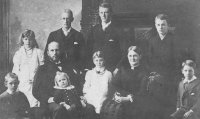 |
The History of the Ryburns -: KINTYRE, SCOTLAND :- |
| Home | Variations | Ayrshire | Kintyre | Ireland | Americas | Au & NZ | Sources | Links | DNA |
| The Kintyre
Peninsula is on the west coast of Scotland, about as close to Ireland
as
you can get without actually being there.
The the mountainous knob on the south end of Kintyre is known as the 'Mull of
Kintyre', the subject of a famous song by Paul McCartney. The only
significant town is Campbeltown, the remotest town in mainland Scotland. Kintyre has a long and complicated history. From about the year 500 it was part of the Scots-Irish Kingdom of Dalriada. From 800 on it was colonised by Norsemen, and in 1098 it came under the rule of Magnus Barefoot, King of Norway. Kintyre was later ruled by Scottish kings, but opposed from time to time by local chiefs. Some claim it to be the 'Cradle of the Scottish Monarchy'. By 1650 Kintye was largely depopulated by war and pestilence. A 'plantation scheme' was sponsored by the Marquis of Argyll, Chief of Clan Campbell, to attract farmers and gentry from the Scottish Lowlands to colonise the land. They were to bring better agricultural practices with them and to exert a 'civilizing influence' on the remaining Gaelic-speaking highlanders. They were 'covenanters', ie, early Presbyterians, and the Ryburns were amongst them. Religious persecution was not intitially a factor, but after Battle of Bothwell Brig in 1679 the Kintyre Plantation became something of a refuge for covenanters fleeing the 'Killing Time' in the Lowlands, when unruly bands of Highlanders terrorised the population. As recounted in Andrew McKerral's excellent book, 'Kintyre in the 17th Century', the earliest Ryburns in Kintyre were John Ryburn and Janet Jamieson, who were in Backs Farm in 1659. Today, East and West Backs farm houses lie just to the east of Campbeltown Airport. Backs was initially in the 'tack' held by the 'heirs of the deceased John Porterfield of Hapland', but the Porterfields did not remain in Kintyre for long. Hapland was next door to the Ryburn lands near Dunlop, in Ayrshire, so John may have been a son of Neil Ryburn, who sold the Ryburn lands to Gabriel Porterfield of Hapland in 1638. From the Earle of Argyll's rental records 1678 (p. 81) we know that John Ryburn was the 'tacksman' in nearby Aros, the day after Whitsunday in 1666. John and Janet probably had many 'bairns', but only a James born in 1660 is in the Campbeltown records. However, Mathew was definitely their son, while Janet and John were probable offspring. The early plantationers used to return to Ayrshire for communion and to baptise their bairns. The Dunlop records were lost. Janet married a James Clark in 1678, six children being recorded. In 1681 they were in 'Knockrioch- more' (Big Knockrioch). John married Jane Sheddan in 1687, producing seven children. They are likely ancestors of many American Ryburns. See the diagram on the right for Ryburn emigrants and their inferred pedigrees. A John and Mathew Ryburn were tenants at Killeonan Farm in 1692, 1706, and also in 1709 with a John Flemming and James Sheddan. The 1709 record states 'Mathew Ryburn the younger', implying there was an older Mathew, perhaps a brother of tacksman John. The only other Mathew we know about was the fourth son of John Ryburn and Jane Sheddan, and he was was just 11 years old at the time. 'ScotlandsPeople' website has an image of a hand-written one-page testament, dated 1706, of a John Ryburn who died at Uigle (Viking word) Farm in December, 1705. The 1694 Hearth Tax (p. 100) also places John in 'Wigell'. The executor of his 'Testament Dative' was his son Mathew Ryburn, of Killeonan Farm. John's goods were valued at 'nyntie eight punds Scots money'. This is the earliest Kintyre testament we know about, and was almost certainly that of the original tacksman John. Other Kintyre Ryburns were probably too humble to have left official testaments -- that is, until 1771 when Campbeltown merchant David Ryburn Junior left 33-pages of testament dative. Also early in
Kintyre were 'Patric' Ryburn and Jane Baird, who were in Garvachie
in 1673 when Jane was born, the eldest of 5 children.
Their second daughter Elizabeth, born in 1676, married the above Mathew
Ryburn in 1696, producing 8 children. Garvachie is a short distance west of Uigle. The 1694 hearth tax records (p. 91)
place Patric in 'Christalloch' (Christlach), where they were in 1680
when the twins Jenat and Patric and were born. Patric may have
been Irish, a descendant of the 'Johne Ryburne of that Ilk'
who was outlawed from Scotland in 1603. On the
other hand, he could have come from Ayrshire, perhaps a brother or
cousin
of the tacksman John Ryburn. However, there is no record of any
Patric Ryburn born in Ayrshire. Patric's Gavachie lease was
probably for the standard 19 years, so he may have arrived in Kintyre before 1662,
perhaps with John Ryburn. My earliest certain ancestors were farmer William Ryburn and Margaret Armour, who married in 1735, raised eight children, and probably lived near Drumlemble. William was most likely the 4th son of Mathew and Elizabeth, but I'm not absolutely sure about that. Most of their children seem to have survived and married. In the Old Kilkerran Graveyard, the ages marked on the graves of brothers James Ryburn, born in 1741, and William Ryburn, born in 1751, pinpoint their parents as William and Margaret. Both sons lived near Drumlemble and both died in 1815. In 1792 William was in 'Kilchivan' (Kilkivan), and by 1800 James was in the East Drumlemble farmhouse he built for himself. James and his wife Jean Smith had 15 children, at least 5 dying as infants. My g x 3 grandfather, William, and his wife Isabell Patterson, bore 9 children, only the eldest, Robert, dying in infancy. All eight surviving children seem to have married -- Alexander and Mathew, on the Isle of Islay. Margaret, Mathew and John all left for North Carolina circa 1826. My g.g.
grandfather, James, was William and Isabell's 5th child, born at
Kilkivan Farm
in 1791 and married to Isabella McNair in 1816.
Earlier in his career James was a baker on Main St in
Campbeltown. His bakery probably corresponds with that of 'H
McIlcherie & Son', 19 Main St , still a bakery in 2010.
I was told that the original old bread ovens still existed behind the
present building. In the 1841 census James's cousin James (47)
was probably the baker there, living in Main Street with his mother Jean nee
Smith (80) and another Jean Ryburn (50), either his wife or sister. James's cousin William was less fortunate. After being evicted from East Drumlemble Farm in 1838 by the Duke of Argyll, the 1841 census shows him, his wife Ann nee Mitchell and four children living in Lorne St. Cambletown. William's occupation is given as 'Carter and Sprit Merchant'. From the online biogaphies of their sons James and William, both William senior and Ann must have died in about 1844. Later, both sons and their elder sister Jane successfully settled in Winnebago County, Illinois, USA, William's family moving on to Hanson County, South Dakota, in 1883. Back to James the Baker. Isabella bore James a total of 15 children, 10 of whom died as infants
and two as children. I originally took this to mean they were a
poor family living in the 'hungry forties', but that was definitely not the case. James' will shows he died quite well-to-do, suggesting
that his former abode in Main Street, Campbeltown, may have been the cause of the gross
infant mortality from water-borne diseases. By way of contrast,
relatively
few babies died amongst their earlier farming ancestors. Last updated 15 Nov, 2015 |
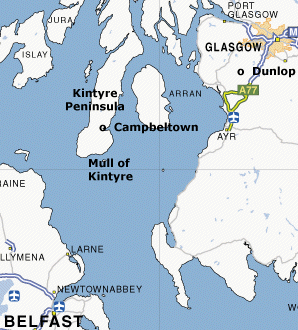 Location of Campbeltown and the Kintyre Peninsula. 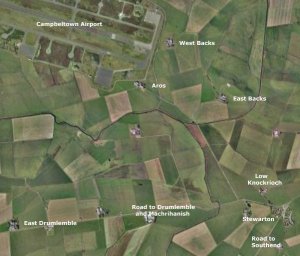 Ryburn Farms near Airport. Click to enlarge. 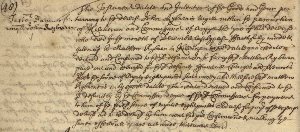 Part of John Ryburn's Testament (Click to enlarge) 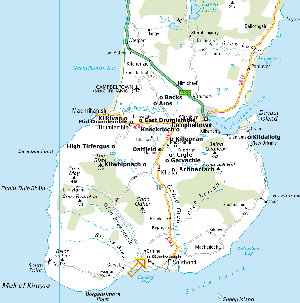 Ryburn Farms in Kintyre. Click to Enlarge 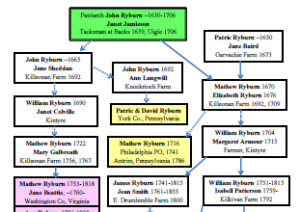 Some Kintyre Ryburns and Migrants. Click to Enlarge 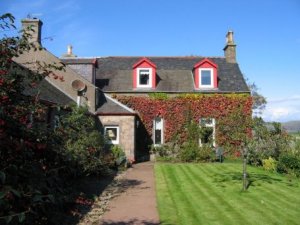 East Drumlemble Farm, built by Farmer James, 1800. 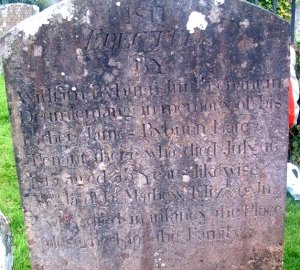 Gravestone of Farmer James Ryburn, erected by his eldest son William. Click to enlarge. Image courtesy Jim & Mureil Adam, Edinburgh. 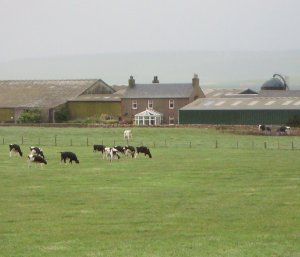 Kilkivan Farmhouse, NW of Drumlemble, birthplace of James 'the baker' and domicile of his father William in 1792. Photo courtesy Paula Ryburn, 2009. 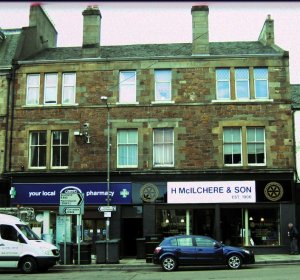 Site of James's bakery, Main St., Campbeltown, still a bakery in 2010. The old ovens are out the back. 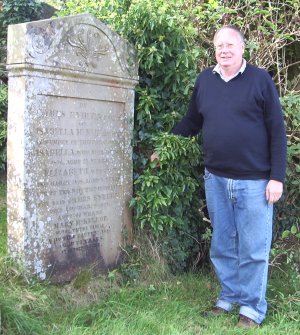 Rod Ryburn at the grave of James 'The Baker', Old Kilkerran Graveyard, Campbeltown. Click to enlarge. |